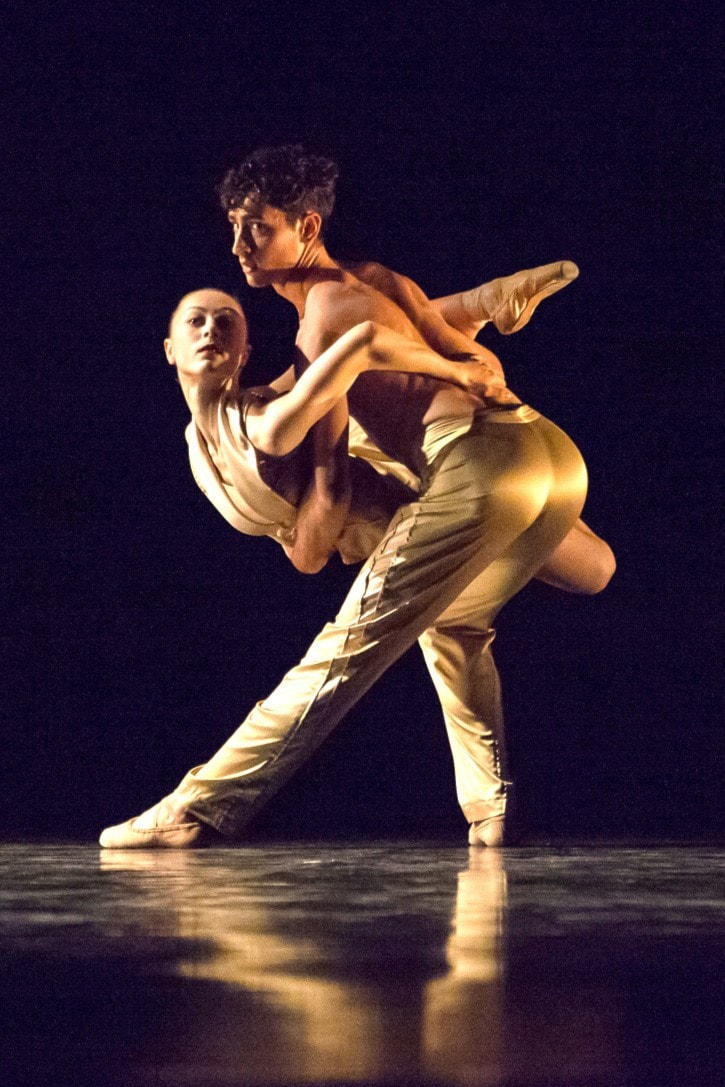Ballet Kelowna will have the honour and Revelstoke audiences the pleasure of partaking in the first professional dance production at the new Revelstoke Performing Arts Centre on Nov. 15.
Revelstoke Museum & Archives curator told me the last time we had a proper theatrical stage was 1922, when the 24-year-old Revelstoke Opera House was torn down.
Artistic Director David LaHay presents the five-part mixed program Double Variations focused around the theme of duelling dancers and choreographers.
The brand-new piece Double Variations debuted in October this year and is one of five pieces featured, but before we get into that, we’ll have to back up to 1975 production of the Canadian masterpiece Lignes et Points by Montreal’s Les Grand Ballets Canadiens.
The pioneering work by choreographers Brian Macdonald and Brydon Paige is based on a simple premise. The collaborators selected music for a piece, then split into separate rooms to choreograph with different dancers. The final production reunites the dancers on the stage in a synthesis of two unique visions.
Ballet Kelowna brought together Vancouver choreographers Simone Orlando and Joe Laughlin to create Double Variations, a conceptual extension of Lignes et Points. (Disclosure: Times Review editor Aaron Orlando is Simone Orlando’s brother.)
This time around, the two choreographers worked together to unite contrasting visions, creating a unique synthesis with Ballet Kelowna dancers.
“It’s a continuation of the idea of two creators coming together,” Orlando said in a telephone interview from Vancouver. “It’s quite rare to see two choreographers working on the same piece.”
Orlando began her dance career in North Vancouver before completing her dance training at the National Ballet School in Toronto. She joined the National Ballet of Canada in 1989 and then danced with Ballet BC for 12 seasons. She began her career as a choreographer in 1997 and has been produced in New York, Toronto and beyond. She also worked at the Stuttgart Ballet alongside Artistic Director and Canadian dance icon Reid Anderson.
Vancouver choreographer Joe Laughlin vaulted from a background in gymnastics into choreography, working on stage dance as well as theatre and TV. He’s the founding Artistic Director of Joe Ink, and has had his works produced around the world.
Orlando and Laughlin have collaborated before. Orlando danced the lead role in Laughlin’s 1996 piece L’Etiquette at the Banff Centre. For his choreography on that production, Laughlin garnered the Clifford E. Lee Choreography Award, a top Canadian choreography award presented to emerging choreographers.
Orlando also went on to win the Clifford E. Lee award a decade later for her piece, Winter Journey, also at the Banff Centre.
Although the contrasting Lignes et Points was the jumping off point, Orlando said the artists opted for a collaboration. “We wanted to be in the studio together, creating and generating all of the movements as a duo,” she said. “We wanted to learn from one another in the process.”
Building on the theme of calligraphy of the body, the pair crafted a predominantly abstract piece combining fluid movements hinged on angular shapes.
“The idea behind it was trying to see how the body or joints of the body could move as though they’re a ball-point pen,” Orlando said, to “draw a little bit from the simplicity of the title of Lignes et Points [translation: lines and points.]”
How was the partnership? “The joke was I’m kind of more detail oriented and he’s big picture,” Orlando said. “The combination of that worked really well.”
Unconventionally, the choreographers worked alongside Vancouver composer James Maxwell, who based the newly-commissioned score on the dance. Maxwell returned to Vancouver and worked with cellist Ariel Barnes and harpist Heidi Krutzen (who form the duo Couloir) to create an original piece named ‘serene.’ The result fuses the unlikely cello/harp combination with electro-acoustics.
“I think that we were both really pleased with the work, and [with] our own process and our own evolution as choreographers,” Orlando said.
Double Variations features costumes by renowned costume designer Linda Chow.
The mixed program features the White Swan and Black Swan pas de deux from Swan Lake. The Kelowna Ballet version is based upon the 1885 Petipa/Ivanov/Drigo revival of Tchaikovsky’s Swan Lake by the Imperial Ballet in St. Petersburg.
Based on traditional Russian folk tales, the dark tragedy is probably more well known today as the basis for the 2010 psychological horror/thriller Black Swan, which was nominated for five Academy Awards and won Natalie Portman the Best Actress award.
The production also features Les Pas de Quatre, an 1845 pieced by French dancer, balletmaster and choreographer Jules Perrot, set to the work of Italian composer Cesare Pugni.
David LaHay’s short work Time Out is also featured.
***
The Revelstoke Arts Council presents Ballet Kelowna’s Double Variations at the Revelstoke Performing Arts Centre on Nov. 15 at 7:30 p.m. as part of their Performing Arts Series. Show at 7:30. Tickets $20 at Talisman Trading on Mackenzie Avenue or the Revelstoke Performing Arts Centre.
